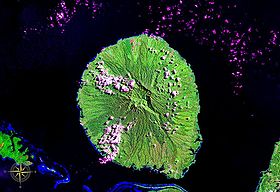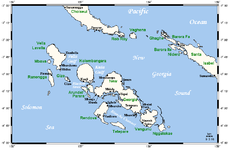
Kolombangara
Encyclopedia


Island
An island or isle is any piece of sub-continental land that is surrounded by water. Very small islands such as emergent land features on atolls can be called islets, cays or keys. An island in a river or lake may be called an eyot , or holm...
in the New Georgia Islands
New Georgia Islands
The New Georgia Islands are part of the Western Province of the Solomon Islands. They are located to the northwest of Guadalcanal. The larger islands are mountainous and covered in rain forest. The main islands are New Georgia, Vella Lavella, Kolombangara , Ghizo, Vangunu, Rendova and Tetepare...
group of the Solomon Islands
Solomon Islands
Solomon Islands is a sovereign state in Oceania, east of Papua New Guinea, consisting of nearly one thousand islands. It covers a land mass of . The capital, Honiara, is located on the island of Guadalcanal...
in the southwestern Pacific Ocean. The name is from a local language, a rough translation of its meaning is "Water Lord" with approximately 80 rivers and streams running down its flanks.
Geography
Almost perfectly round in shape and about 15 kilometres (9.3 mi) across, the island is a stratovolcanoStratovolcano
A stratovolcano, also known as a composite volcano, is a tall, conical volcano built up by many layers of hardened lava, tephra, pumice, and volcanic ash. Unlike shield volcanoes, stratovolcanoes are characterized by a steep profile and periodic, explosive eruptions...
that reaches an altitude of 1770 metres (5,807.1 ft) at Mount Veve
Mount Veve
Mount Veve is an extinct volcano on Kolombangara, in the Solomon Islands, at . It is 1768 m tall and is the highest point of the island.- External links :*...
. The island forms part of the southern boundary of the New Georgia Sound
New Georgia Sound
New Georgia Sound is the body of water that runs approximately through the middle of the Solomon Islands. The Sound is bounded by Choiseul Island, Santa Isabel Island, and Florida Island to the north, and by Vella Lavella, Kolombangara, New Georgia, and the Russell Islands to the south...
; to the northwest the Vella Gulf
Vella Gulf
Vella Gulf is a waterway in the Western Province of the Solomon Islands. It lies between the islands of Vella Lavella to the northwest, Kolombangara to the southeast, and Ghizo to the south...
separates it from Vella Lavella
Vella Lavella
Vella Lavella is an island in the Western Province of the Solomon Islands. It lies to the west of New Georgia, but is considered one of the New Georgia Group...
and Gizo
Gizo
Gizo is the capital of the Western Province in the Solomon Islands. With a population of 6,154 , it is the second largest town in the country. It is situated on Ghizo Island approximately 380 kilometers west-northwest of the capital, Honiara, and is just southwest of the larger island of Kolombangara...
, while to the southeast New Georgia
New Georgia
New Georgia is the largest island of the Western Province of the Solomon Islands.-Geography:This island is located in the New Georgia Group, an archipelago including most of the other larger islands in the province...
lies across the Kula Gulf
Kula Gulf
Kula Gulf is a waterway in the Western Province of the Solomon Islands. It lies between the islands of Kolombangara to the west, Arundel Island to the southwest, and New Georgia to the south and east. To the north, it opens into New Georgia Sound...
. West-Southwest of Kolombangara is Ghizo Island
Ghizo Island
Ghizo Island, home to Gizo the capital of the Western Province, Solomon Islands. The island is named after an infamous local head-hunter. It is located west of New Georgia and Kolombangara....
, upon which the Western provincial capital Gizo
Gizo
Gizo is the capital of the Western Province in the Solomon Islands. With a population of 6,154 , it is the second largest town in the country. It is situated on Ghizo Island approximately 380 kilometers west-northwest of the capital, Honiara, and is just southwest of the larger island of Kolombangara...
is located.
Kolombangara is heavily forested, with few inhabitants. Kolombangara has two notable settlements, Ringgi and Mongga, the former being the larger. The most significant industry on the island at this time is logging, with the largest of these based at Poitete.
World War II history
During World War IIWorld War II
World War II, or the Second World War , was a global conflict lasting from 1939 to 1945, involving most of the world's nations—including all of the great powers—eventually forming two opposing military alliances: the Allies and the Axis...
the island and the waters around it were the scene of much fighting. The Imperial Japanese Army
Imperial Japanese Army
-Foundation:During the Meiji Restoration, the military forces loyal to the Emperor were samurai drawn primarily from the loyalist feudal domains of Satsuma and Chōshū...
used an airstrip on some flat ground at Vila on the south shore of the island, and in May 1943 based several military units with over ten thousand troops garrisoned on the southeast side of the island under the command of Major General Minoru Sasaki
Minoru Sasaki
-External links:- Translation of the official record by the Japanese Demobilization Bureaux detailing the Imperial Japanese Army and Navy's participation in the Southwest Pacific area of the Pacific War.-Notes:...
, in an attempt to establish a defense line through the Central Solomons. Naval battles nearby included the Battle of Kula Gulf
Battle of Kula Gulf
The naval Battle of Kula Gulf took place in the early hours of 6 July 1943 during World War II and was between United States and Japanese ships off the coast of Kolombangara in the Solomon Islands.-Background:...
and Battle of Kolombangara
Battle of Kolombangara
The Battle of Kolombangara was a naval battle of the Pacific campaign of World War II, fought on the night of 12/13 July 1943, off Kolombangara in the Solomon Islands.-Background:...
.
The most famous battle was the mission to intercept the "Tokyo Express
Tokyo Express
The Tokyo Express was the name given by Allied forces to the use of Imperial Japanese Navy ships at night to deliver personnel, supplies, and equipment to Japanese forces operating in and around New Guinea and the Solomon Islands during the Pacific campaign of World War II...
" supply convoy which resulted in the ramming and explosion of U.S. torpedo boat PT-109
Motor Torpedo Boat PT-109
PT-109 was a PT boat last commanded by Lieutenant, junior grade John F. Kennedy in the Pacific Theater during World War II...
, manned by John F. Kennedy
John F. Kennedy
John Fitzgerald "Jack" Kennedy , often referred to by his initials JFK, was the 35th President of the United States, serving from 1961 until his assassination in 1963....
and his crew. Australian coastwatcher
Coastwatchers
The Coastwatchers, also known as the Coast Watch Organisation, Combined Field Intelligence Service or Section C, Allied Intelligence Bureau, were Allied military intelligence operatives stationed on remote Pacific islands during World War II to observe enemy movements and rescue stranded Allied...
, Sub Lieutenant Arthur Reginald Evans
Arthur Reginald Evans
Arthur Reginald Evans was a shipping clerk at Paddington, a suburb of Sydney, when he enlisted in the Australian Imperial Force on 25 July 1940. He was allotted service number NX57823 and served with the 2/9th Army Field Regiment, Royal Australian Artillery until discharged on 9 October 1942 as a...
, who manned a secret observation post at the top of the island's Mount Veve volcano, spotted the explosion. After decoding news that the explosion he had witnessed was probably from the lost PT-109 he dispatched Solomon Islanders
Solomon Islands
Solomon Islands is a sovereign state in Oceania, east of Papua New Guinea, consisting of nearly one thousand islands. It covers a land mass of . The capital, Honiara, is located on the island of Guadalcanal...
Biuku Gasa and Eroni Kumana
Biuku Gasa and Eroni Kumana
Biuku Gasa and Eroni Kumana were indigenous people of Solomon Islands, of native Melanesian descent, who found John F. Kennedy and his surviving PT-109 crew following the boat's collision with the Japanese destroyer Amagiri near Plum Pudding Island on 1 August 1943...
in a dugout canoe to look for possible survivors. Their courageous efforts led to the subsequent discovery and rescue of John F. Kennedy and the surviving crew.
After destroyers succeeded in sinking the supply ships 3 nights later and isolating the garrison of 12,400 there, US forces were able to "leapfrog" Kolombangara to land on Vella Lavella
Vella Lavella
Vella Lavella is an island in the Western Province of the Solomon Islands. It lies to the west of New Georgia, but is considered one of the New Georgia Group...
to the west. The Japanese evacuated Kolombangara between September 23 and October 4 1943.
In January 1944 a detachment of 1 officer and 6 enlisted men from the 350th Engineer General Service Regiment stationed at Munda, established a vegetable farm on the Japanese abandoned airstrip at Vila. The British government furnished 16 male natives to help with the project. With seeds acquired through the International Red Cross, many vegetables were sent back to the base hospital to supplement the dehydrated meals served the recuperating veterans. The main item was watermelon
Watermelon
Watermelon is a vine-like flowering plant originally from southern Africa. Its fruit, which is also called watermelon, is a special kind referred to by botanists as a pepo, a berry which has a thick rind and fleshy center...
s that both natives and men enjoyed. The natives were taught how to save the seeds and replant them in their own gardens.

